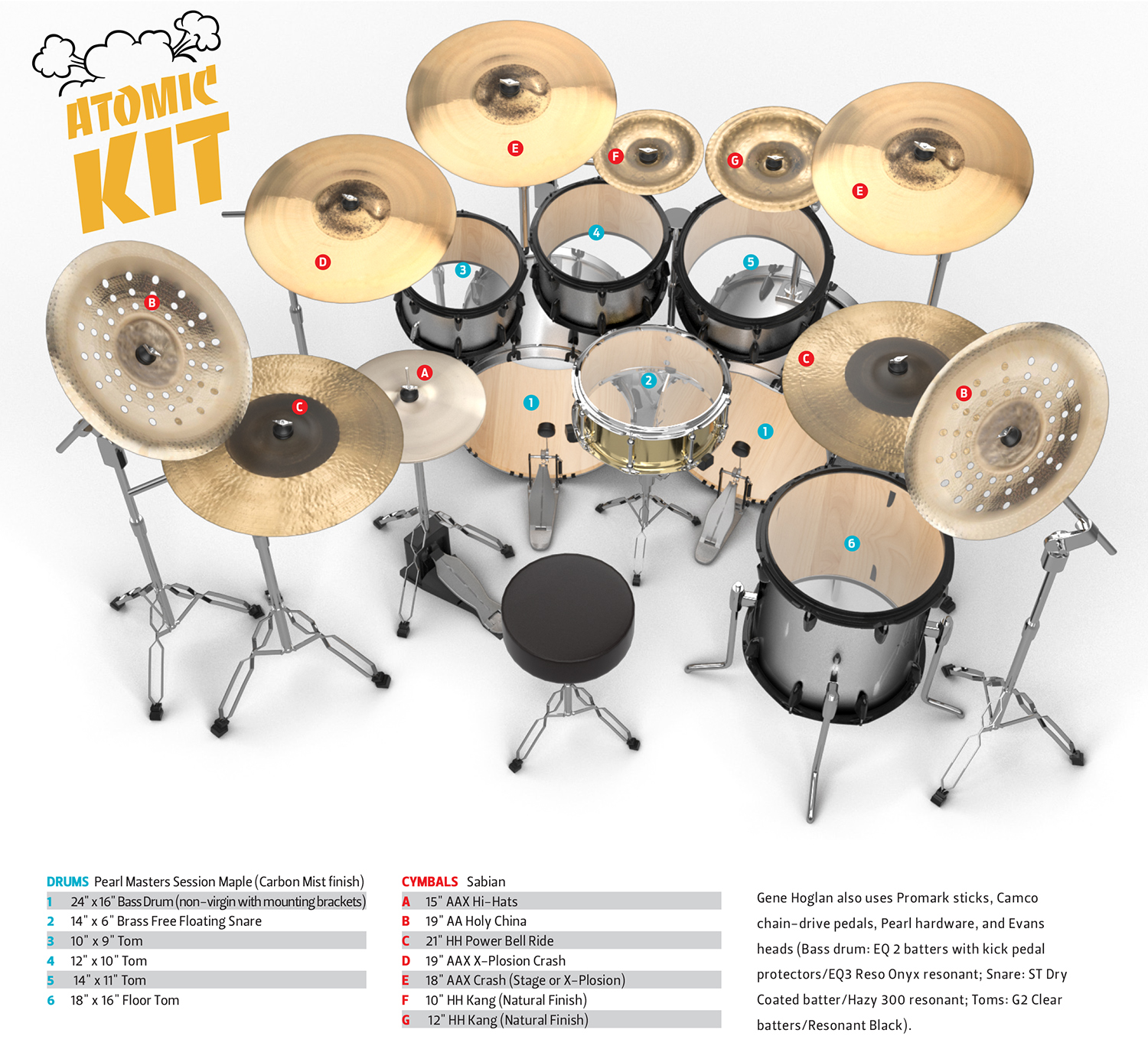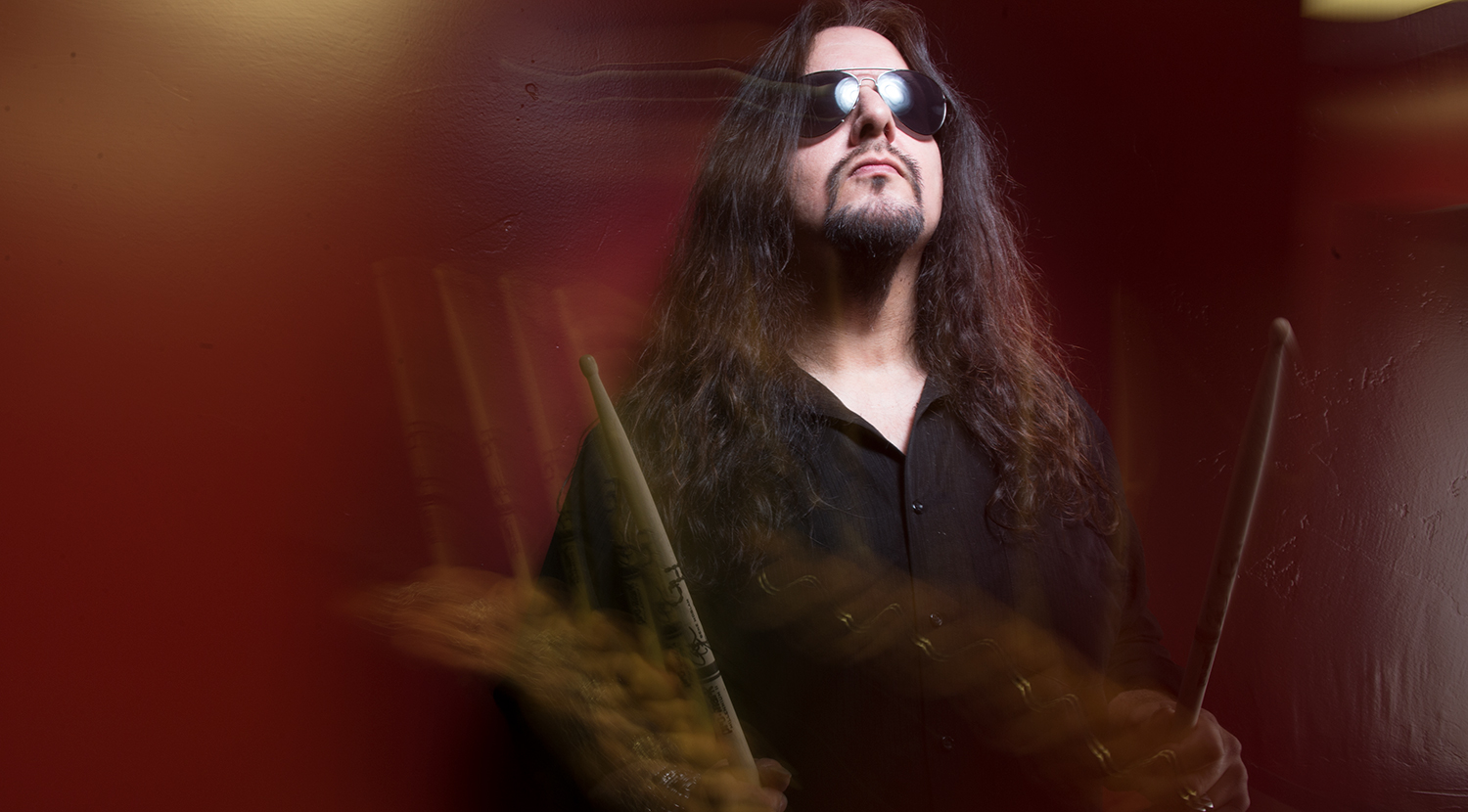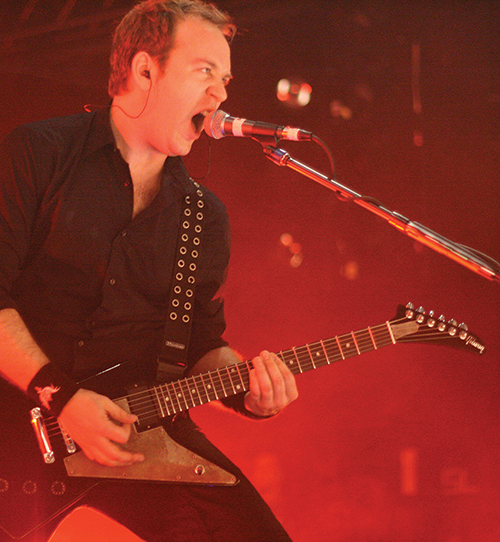From the January 2017 issue of DRUM! | By John Payne | Photography by Robert Downs
Observing master metal man Gene Hoglan do what he does, one is presented—after picking their jaw up from the floor—with a simple question: “Where did this awesome drumming beast come from?” The versatile veteran drummer has made technically fearsome magic with so many essential metal bands, from his early
Dark Angel years to genre-defining contributions with Fear Factory, Death, Strapping Young Lad, Meldrum, the virtual metal band Dethklok, and his current and longstanding run with Testament, whose brilliance blasts mightily on their just-out Brotherhood Of The Snake.
Down-to-earth Hoglan is not just a master musician, he’s an entertainer and teacher as well, who takes his comedic drumming wisdom on the road in presentations of The Gene Hoglan Experience, in which the good-humored motormouth regales fans with behind-the-curtains tales of the rock biz. His excellent new DVD, The Clock Strokes Two, is a super-informative instructional video that breaks down in crystal-clear HD sight and sound how Hoglan executes his wizardry.
Gene Hoglan: Master Blaster
ANGELS AND DEMONS AT PLAY
The self-trained Hoglan has been doing it for three decades-plus, and he still digs it. He got his start at age eight, air-drumming to Kiss, Rush, and Pat Travers albums, and, crucially, listening to a lot of music that had nothing to do with hard rock. “I’d have my little albums out by the drum set and play along to whatever: Iron Maiden, Saxon, Mötörhead, Rush, Gino Vannelli.
It was all heavy for me. I remember air drumming to UK’s live record Night After Night. I’d never taken a drum lesson, but I figured all those songs I played along to was a drum lesson. And you know how when you’re a kid, your parents always have the worst musical taste and part of what drives you is your hatred for your parents’ music?
Well, I always liked my parents’ music; they were always playing doo-wop, mariachi, soul—or Jesus Christ Superstar. And they were like, ‘Our kid likes loud rock and roll—okay, that’s all right.”
Hoglan started playing on the kit when he was 13, and at age 15 joined his first band with a few guys from his high school. They were called Dark Angel—not to be confused with the other Dark Angel band that Hoglan played with a few years later.
“I did not name either band,” he says. “As a matter of fact, when I first joined this high school band, I made them change their name because I thought Dark Angel was a silly name!”
By the time he was 13, Hoglan was going to clubs in L.A. (“I was 6-foot-1, and they didn’t card at clubs like they do now!”), and at 15 was working for some of his favorite metal bands playing there, setting up gear and doing lights for the likes of Slayer.
“One day, their manager didn’t show up to one the gigs, and Tom [Araya] turned to me and said, ‘Hey, man, do you know how to run lights?’ and I said, ‘Sure.’ He showed me the board and it looked pretty simple and I said, ‘Ah, I can do this.’” Hoglan hit the road with Slayer as their lighting tech, during which time, Hoglan legend has it, he helped Lombardo develop his double kick drum technique.
“The very first double bass kit that I ever played on was Dave’s,” he says. “A couple of months before they recorded [1983 debut album] Show No Mercy, Dave had added the second kick. When I went down to the Show No Mercy recording sessions, he was only using a single kick, and I was like, ‘Wait a minute, you’ve already done a gig with double bass.
I watched you play with a double bass kit!’ And he said, ‘I couldn’t get my double bass together in time for the recording, so I figured I could just use single bass. I’m good at that.’”
Lombardo went back to playing double bass, but it wasn’t getting any easier for him. “I remember going to one of their rehearsals one afternoon and Dave was explaining to me all the issues he was having, like, ‘I’m having problems lining up my left foot; it just wants to lag behind.’
I sat behind his kit and just started flying on the double bass, and he said, ‘Hey, wait a minute: I’ve been to your house, I’ve played your kit, you have a single bass. How long have you been playing double bass?’ And I looked at my watch and said, ‘What time is it? I’ve been playing for five minutes.’”
Over the next few months, Hoglan gave Lombardo tips and pointers on double bass technique. Within six months Lombardo’s double bass work was intense enough (with Hoglan’s onsite pep talks) to pull off Show No Mercy’s “Haunting The Chapel,” “which, at that time,” says Hoglan, “was the most brutal double bass ever written. Like, wow, those bass-drum thirty-second-notes don’t ever stop for the first two minutes of the song. Damn!”
With Hoglan in tow as lighting tech, Dark Angel and Slayer played several shows together on a few tours, and Hoglan became friends with Dark Angel guitarist Jim Durkin. “I guess I was a really cocky kid,” he says. “In the summer of ’84 I went up to Jim Durkin at one of their gigs and told him, ‘Your drummer is not very good.I should be your drummer.’ Jim was like, ‘Okay, put up or shut up. Let’s hear what you got.’ I went down to jam with them and they liked it. They had their drummer for a little while longer and I guess he didn’t work out, so I got the job.”
Hoglan stayed with Dark Angel for several years, eventually writing not only the drum parts but a lot of the riffs and melodies for the band’s albums. “My vision for Dark Angel was to be super heavy, super intense, just as heavy as we could be.
Dark Angel at that time had a bunch of different ideas, like, each member had a different idea of how they wanted the band to sound. I started writing riffs immediately for them, and a major chunk of a couple of tunes, including ‘Black Prophecies.’”
Hoglan took over writing the lyrics for Dark Angel, too, and by the time Leave Scars came around, he was writing a lot more. “And there were a couple of songs that I played the guitar on just because I think my riffs were getting so technical that the other guitarists were kind of like, ‘Man, you wrote it, you record it, dude.’ I was like, ‘Cool, I’ll do that.’ I had no idea what I was doing. I could play guitar, but not recording-worthy.”

Infographic: Juan Castillo
THE DRUMMER HEARS ALL – GENE HOGLAN
What the drummer brings to music composition can be something very special, a way of thinking about prickly rhythms that can lead to ultra-complex (and, for guitarists, often initially unplayable) riffs and melodies that could only have been contrived by a rhythm architect.
“I’m at a point now where I can easily tell when a drummer writes some of the music,” says Hoglan. “But I’ve had so many complaints from guitarists who say, ‘We can’t play your riffs.’ I’m showing them my stuff and they’re just looking at me, slack-jawed: ‘Wait, what?’ Yet, I’m not thinking that these things are anything crazy or even trying to write some technical, crazy riff. I’m just showing you a riff.
“There’s been so many times when I have received a demo from one of my guitarists and it has their drum programming on it and they say, ‘Look, I don’t know how to program. I just click some beats down on here and I know there are spots where it sounds like the drum machine has four arms and three legs, and I don’t expect you to do that. But I couldn’t simplify it any more than that.’ That’s when I say, ‘Well, hey, I guess I’ll try to learn that beat you programmed.’
“When I started working with Devin Townsend [Strapping Young Lad/Devin Townsend Project], he was a good drum programmer, but there were certain beats that he would lay down where I was like, ‘Wow, I wouldn’t have thought of that, but since it’s part of your vision for programming these drums, I’ll try to play that very unnatural beat.’ That would then get absorbed into my approach.”
ANATOMY OF A BLASTBEAT
“It isn’t easy trying to do a blast when you’re not a blast drummer,” says Hoglan. “Kudos to anybody who tries it.” That most gruesomely wicked of drum techniques is an item whose very definition has gotten pretty vague over the years. What exactly is it? Where did it come from? And where is it going?
“There are basically two different styles of the blastbeat: the unison and the alternate,” he says. “I can never remember the name of the blastbeat that Strapping Young Lad used, but it’s unlike the Suffocation approach or the early Nick Barker approach with Cradle Of Filth, where your snare and your China or cymbal are going at the same time. A lot of the time the double kick drum is doing real simple sixteenth-notes underneath.
“Early on, a lot of guys would play with a single kick—I’m really impressed with those guys. That was Strapping’s approach, the unison blastbeat, and with that band I found that just going ba-ba-ba-ba-ba-ba-ba-ba with the kicks underneath could become a little stale-sounding when there’s a million of those going on at the same time.
And when you’re doing everything in unison when you’re recording, it doesn’t make for a lot of dynamics on the drums. So why not create some fun patterns on the kick drums underneath? With Strapping I’d take a marching drum approach with the kick drum, try to come up with some militaristic-sounding pattern under the ba-ba-ba-ba-ba-ba-ba-ba on the top.”
With Testament, however, bandleader Eric Peterson likes the European-style blastbeats, the black metal style where the hands alternate between ride and snare, while the double bass plays different patterns underneath. Generally speaking, a blastbeat is a very staccato rhythm, because there isn’t a whole lot of ornamentation—you always follow a hit with another hit. And the sharper you play it, the better it sounds.
“I gotta admit,” says Hoglan, “back in the ’80s and early ’90s, when we would hear the earlier versions of what would become blastbeats, to us thrash metal drummers, who would do double time on the hi-hat and double time on the ride with your hi-hat hand, it was like the drummer was playing what we’d call ‘cut time,’ meaning the drummer was only alternating because he couldn’t do double time on the ride. He could only do one ride, one snare, one ride, one snare.
But if you speed that up a little bit, that is an early blastbeat. Bands like Hirax and Cryptic Slaughter, and Mayhem from New York City, an early blastbeating band, those guys were all doing cut time, but it was kind of fast. Then bands like Napalm Death came along and sped that up even more. Then it was bands like Carcass and all the European grind bands that came out from those late-’80s, early-’90s eras.”
All these bands, he says, really did master these rudimentary blastbeats, “but for us ‘real’ drummers [laughs], a blastbeat in the early days was kind of a shortcoming. It was like, “Damn, that drummer is trying to go fast, but he can’t get his right hand on the ride cymbal to do anything other than do-pa-do-pa-do-pa-do-pa-do-pa. He couldn’t go ta-ta-ta-ta-ta-ta-ta on the ride. So ‘real’ bands didn’t take them seriously when they started.”
It wasn’t until he heard The Principle Of Evil Made Flesh by Cradle Of Filth that Hoglan got the feeling and intent of the blastbeat. “I was like, ‘Wow, that sounds powerful and like [Nick Barker] is actually meaning to do this. That was an exciting moment for me. It was like, ‘I finally get the blastbeat. Where to go next?’”
Next for Hoglan was a thorough examination of what lies at the core of the blastbeat. Though it appeared to be nothing more than a cluster of notes played by dividing up the hits among four limbs, well, that didn’t turn out to be the case.
“There’s not much division going on,” he says. “If you’re playing, say, that Nick Barker style of blast, that’s usually alternating sixteenth-notes on the feet, and then you’re doing those same sixteenth-notes with your right and left hands in unison. So at first there is a challenge there, a muscle training, because when you try to do that beat out of nowhere, you get tired really fast.
Whereas you could play alternating thirty-second-notes on your hands and you could do that all day long. But when you throw a double bass underneath the alternating thirty-second hand notes, that would be in the European style of blast. You might think, ‘All I’m doing is an alternating single-stroke roll on my ride and on my snare.’ But even that becomes challenging.
“It does take a little bit to develop the blast. I remember when I started playing with Strapping, and there were all these blasts on this new stuff that Devin was writing, which turned into the City album. I was like, ‘Whoa, there’s a whole lot of this stuff. I need to practice this,’ because I’d get tired after just a couple of rounds of it. It took a little concentration.”

HOGLAN RIDES AGAIN
Gene Hoglan’s a big man who used to be much bigger. Normally a little extra weight shouldn’t affect a drummer’s speed and dexterity, and in Hoglan’s case it didn’t—but it did affect his future prospects, somewhat.
“I had diabetes for ten to sixteen years,” he says. “I was not taking good care of myself. For example, I went down to South America with Fear Factory and after every show we went to those churrascarias for dinner, where they just throw a ton of meat at you. I indulged so much that I put on an extra 20 pounds, and I was 390 at the time. I came back and I was 410.”
Hoglan’s doctors informed him that if he didn’t do something about his weight, they were going to have to start insulin injections. His girlfriend, however, put him on a borderline vegetarian diet—no more Burger King or Jack In The Box—and within six months he’d beaten the diabetes and dropped 160 pounds in the bargain.
It’s a health regimen he’s stuck to, and which has definitely benefited his ability to play the long game. “The extra weight did affect my stamina, like any time if I would have to do a long double bass pattern, that would take a little more out of me. Now, those parts are easier. I’m pulling a lot less weight to do that.”
Hoglan’s speedy stamina behind the kit is a bit surprising. For all the billion notes he plays per minute, you really don’t see him moving all that much. Perhaps, he says, that initially owed to all the extra poundage he was packing. Whatever the case, he’s developed a technique that allows him to point his energies to his wrists, fingers, ankles, and toes.
“I used to be a heels-up player, and even when I used heels-up, I used so much ankle that my knees never really moved up and down, they weren’t a real churning style,” he says. “Playing some of these velocities and tempos that we’re playing, you couldn’t crank legs my size that fast up and down, so it’s okay to learn how to do this from your ankles and your wrists.
While it doesn’t look like I’m doing a lot, there’s just a little snap at the end of every hit that is the briefest of milliseconds. That little snap doesn’t look like a big pile of energy is being produced, but I’d take the velocity Pepsi challenge with any drummer in my style and see who’s the loudest.”
A real head-scratcher to most other heavy-rock drummers is the fact that Hoglan plays his ferocious kick drum patterns mostly heel-down. “It’s an amalgam, but any fast parts where the drums are super-hauling, that for me is all heels-down now,” he says. “It was around the Dethklok/Fear Factory era that I was finding I wasn’t getting enough power when I was playing heels-up when I was playing the fast double bass.
I had a lot of power, but my body just started feeling imbalanced when playing fast stuff heel-up. So I said to myself, just plant your heel and see how that works for you. And I was like, ‘Holy s**t!’ Where before I would have to lean back to play fast double bass, now, when I put my heel down I lean into it. This is even louder!”
Steve Di Giorgio: Bassic Communications
What’s the secret to getting along with bass players? Listen! Apparently our four-stringed friends are a sensitive lot. They feel that we’re too busy scattering blastbeats hither and yon to even notice what they’re doing. At least that’s what Steve Di Giorgio says, which is why he’s Gene Hoglan’s fan and friend as well as his colleague.
“When you play extreme metal, a lot of drummers focus only on technique,” observes the Testament bassist, who calls this obsession “metronome abuse.” “But it’s good to have a little waver in your time, not necessarily going out of tempo but bending and moving to the feel of the song. Gene really excels at that.”
Di Giorgio attributes this to Hoglan’s awareness of what’s going on around him, particularly in the bass department. “In this type of music, most of the time the drummer writes his part,” he says. “The bass player learns it and builds a line that fits around it. Gene is different. He’s the first drummer who will change accents or do things a little differently based on what he hears me play.
He’ll look over to my side of the rehearsal room and say, ‘Hey, I like what you just played! That’s a really cool accent. I’ll change what I do there to go with it.’ And I’m like, ‘Wow, this is new — a drummer who cares about what the bass player does!’”
The same dynamic applies onstage with Testament as well as the band Death, with whom they also play together. “I might throw some improvised licks into a song onstage,” Di Giorgio says. “Gene always wears these sunglasses — something to do with stage lights — and I’d see him tilt his head back and look underneath his glasses at me, like, ‘I heard that!’ Then he’d answer my line.
So I’d play something else and he’d be on it. We started straying so much that we got a talking-to in the bus later that night. The guitar player was like, ‘Look, I like that you guys are having fun, but when I’m coming out of my solo and I can’t even find 1 – we’ve got to do something.’
“We were like, ‘Okay, we’re sorry. We won’t do it anymore. And,” Di Giorgio reveals, “we found another place to do it instead.”
Brendon Small: Rewinding Dethklok
 Playing with Testament involves tearing through complex arrangements at brain-melt tempos, never missing a curve or dropping a beat. Playing with death metal specialists Dethklok is a little bit different; there’s a little more breathing space, more of an emphasis on harmonic structure.
Playing with Testament involves tearing through complex arrangements at brain-melt tempos, never missing a curve or dropping a beat. Playing with death metal specialists Dethklok is a little bit different; there’s a little more breathing space, more of an emphasis on harmonic structure.
Yet Gene Hoglan kills it in both settings, according to guitarist, songwriter, and occasional stand-up comedian Brendon Small, who is wrapping up a Dethklok project with the drummer for release likely in early 2017.
Give-and-take is central to their musical relationship. “There’s nothing more boring than one person’s point of view,” Small insists. “So I take whatever material I have, get it to Gene, and say, ‘Look, this is the idea of the song. Is anything striking you? Do you have an idea for a pattern that beats one of my patterns, that locks more into a groove? Do you want to just contradict everything I did and see what happens?’ And if he does, it’s usually great.’”
Though the titular leader of Dethklok, Small sees his work with Hoglan as collaborative, largely because both have reached a point of focusing less on building chops than on using them intuitively. “It’s like making money,” Small explains. “Once you have some, you don’t think about it all the time.
I think Gene has the money and he’s not worried about it, so he gets to concentrate not on the technique, even though it’s there, but on the whole reason we’re doing this, which is to make music. Whether he’s playing slow or pummeling this epic thrashy stuff, he sees the song through it all.
“And we constantly look ahead,” he elaborates. “I’ll say, ‘As far as playing fills, we have to think about the section after this, not the section we’re in.’ That’s most of our conversation: What are we building to? Are we building to a double-time? A half-time? Ultimately it’s about what the song wants.”
Small is even open to a rare mistake from Hoglan, which apparently can inspire more than other drummers’ actual ideas. “There was a moment on the Dethklok album where Gene dropped his sticks while we recording — and it sounded really cool with no drums there,” he reports. “It created a dynamic shift where everything stopped. So I said, ‘Leave that in! And make more mistakes like that!’”

